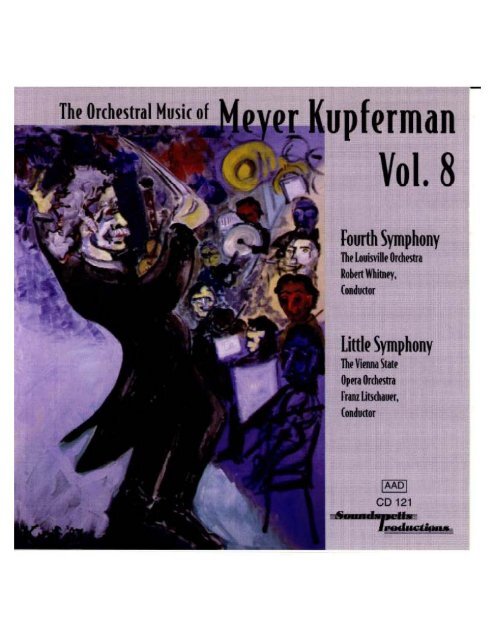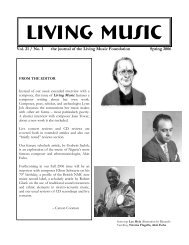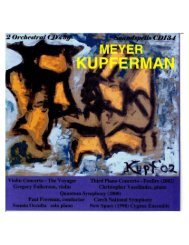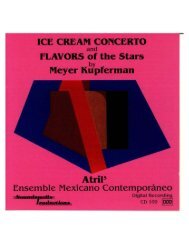THE ORCHESTRAL MUSIC OF MEYER KUPFERMAN, VOL 8 ...
THE ORCHESTRAL MUSIC OF MEYER KUPFERMAN, VOL 8 ...
THE ORCHESTRAL MUSIC OF MEYER KUPFERMAN, VOL 8 ...
You also want an ePaper? Increase the reach of your titles
YUMPU automatically turns print PDFs into web optimized ePapers that Google loves.
Th. OrchntTiI Music of<br />
Vol. 8<br />
lIItl ' ..... lb •<br />
.... > j.<br />
( '.<br />
I.ittIf SYllPhony<br />
110 __<br />
.........<br />
r<br />
.. lbt i,<br />
(P'.<br />
~<br />
CD 121<br />
• I t<br />
;" •
<strong>THE</strong> <strong>ORCHESTRAL</strong> <strong>MUSIC</strong> <strong>OF</strong> <strong>MEYER</strong> KUPFERMA N, <strong>VOL</strong> 8.<br />
Fourth Symphony (1955)<br />
by Meyer Kupferman<br />
TIle Foor1h Symphony. commissM>ned and recurlkd by tne Louisville Orchestra. was<br />
composed in the mid-1950'~ during a period of intense musical CltplOnli ioll for Meyer Kupfemlan.<br />
Works during this time incl ude Ihe Linle Symphony (on this CD) and the C hambtr Symphony<br />
(COl J 2). All of these works were well , ~'CdV l·tllJy crilk's and audiences, bul the Fourth Symphony<br />
represented a major tumin~ point in Kupferman's musical style and in his expressive aesthetic.<br />
IIKlecd. ils staggering passion. ils boundless thematic im 'cntion and il5 curious limbrJ.i colorations<br />
a ll combine to make il unique.<br />
The Symphony is based on a chapter of Dostoevsky's great novel, 'The Rll)lhers Karamazov. n<br />
clilled ''The Legend or The G rand Inquisi tor," It is said to be Ihe greatest section of the greatest<br />
nO\'el ever wri l1en. The story is told by one of the brOlIIl:rs about halfway through the fIOvd. In<br />
brief. it recoont) the terrible day!> of the Spani ~ h Inquisition whcn the Gronel Inquisitor hem that<br />
wmcooe p!Y.>ing as the Christ is performing alleged mi ...l(:ies for ttlt poor. The Grond Inquisitor<br />
\'enlU~ imo the W'CCIS and sees for himself Ihat this i"dh'idual is performing genuine miracles and.<br />
amazingly. is indeed the Christ Himself. resurre
al ways fall ba,'k [0 [hI! pervasive brooding of the initial mood.<br />
A call 10 arms, the opening Frcll(;h hom signals or the second movemcRI in agit:ltcd. rising<br />
fifths. exhibit a sharp. mlhtansuc character. Spa ni ~ h pomp and the clashing of swords and amlOr<br />
can bt heard. This is undo ubtedly a musical depiction of the SP'lnish Crusndes, exemplified by<br />
brutish. bullying statements in the brass and smoky string trills countered by ::angry SlacCalO<br />
woodwiod phrases. Here the " 1\'Iuss es scin '.'"" moth'c returns in counterpoint Wilh the crucifonn<br />
Bach mOthc.<br />
The third movcrncnI. an cKq uisile adagio finale. is a giant fugue based on the name of Bac h<br />
and suggests the long diSCOUrse of the U rand Inquisitor [0 Christ in prison. Kupferman possesses<br />
here a seemingly inexhaustible knack for moli ... ic lmnsformalion. sustained and rising linear designs<br />
und \'uricd orchestral color, The lo ngjouruey o f the fugue w ntains dozens of entriM and episode~<br />
which express the spectrum of passion and hOfTQr. This putS the human eondition on an epic level<br />
as Ihe fugue reaches for ils incredibly gentle climax in lhe highest and mosl distant regions of<br />
orchestral sound. The composer has asked himself for many years. " What is the me:lIling of the<br />
kiss TIle depiction I ha"e made: lit this point in the fugue is still unsenling and doesn't answer all<br />
tht' questions." A brief cod:! follows in which the Ihree ootc.~ of the " Muss es scin': motive is once<br />
agai n ~ tated . as if all of thi ~ "must be:' and the symphony dies away into silence and inconsolable<br />
sadness.<br />
Little Symphony (1952)<br />
-<br />
Meyer Kupferman's Linle Symphony. eom mi~~ ioned by Daniel Saidcnberg (or his elas.~icl . 1<br />
orchestra ealled'1l!c Saidenberg Little Symphony." was premiered at the 92nd Street YMHA in<br />
New YorK City. Its orcl'ICstration was drawn (rom the other main work on the program. a Haydn<br />
piano conceno.<br />
The spirit of Kupfennan's Lillie Symphony is infused with a sense: of youthful playfulness<br />
and good humor. This is immedi31cly apparent in the firs t mO\"l.~men1. a tr.lditional sonata-allegro. as<br />
the opening chords establish the tonality of the piece (D major) in no uncertainterllls with a ~1Ul'l t y<br />
low f -n3tural in the bass to attack the tonal ity. Grudually rapid string arpcggintions work against<br />
the orchcstral chords and allow the more gentle S\.'Cond thclIl\: to \:l1Icrge in II gnlCcful cross·rhythm .<br />
Cenainl y the influen"es of Stl'Uvinsky and Prok olierr~ neo-classical works lire apparent here.<br />
especially in the unsettled character of major'minor harmo nic juxtapositions, The dancclikc naturt<br />
of the lirst nll)\'cmenl is often punctuated by delightful cOl1trJpunlal episodes. The de\'elopment<br />
section is full of intensc harmony not unlike what one would lind in a MOllin dc'
mo\'emcnt there is II play between ~ u ~ laincd loOlmds lind SUICcuto woodwmd pohr3St:s and Ih i~<br />
l'Ounlerpoinl bcromcs rt1OI"e llpparcnt al ils close.<br />
A cadenza interlude which comllXb tile second and third mO\'CmenlS begins with an abrupt<br />
o r ~he s tnil recitative /lnd in[ rod ~s a cello cadenza which the composer YCJl'$ latcr ;tdmilled he<br />
wrote because the cond uctor, Daniel Saidenberg, was a great cellist and Kupfennan OOflccivcd it<br />
as u tribute 10 him.<br />
S Llddcnly the finale j umps OUI III us in a Oying prc~ l o. TIlCrc h a pan icularl y 11;lIiao, en'n<br />
Rossinicsquc. character 10 Ihis movement, especially in the ornate and rapid violin melodies<br />
whICh are p!"e\'alent throughout. {\ demonic nurry of figuratio ns carries Inc mo\'cmem through 10<br />
the end until a surprise F m:ljor cadence in~inua l ~ itself 1100 whips us back 10 the final 0 major.<br />
MC)'er Kupferman wrote the Lillie Symphony "out of character," thm is. against the mold<br />
the mu ~ical world had expected of him . A trailbl azing Illonal composer was 1l0( supposcd to write<br />
a tonal . unapologctic. cla SSicall y constructed work.. Bul this composer was beginning to realize<br />
he needl.--d to follow his own convictions and nOI the expectations of the world around him. In his<br />
o\Oo'n words. Kupfennan needed to "gel this large "11urk on paper and get the need 10 salisfy<br />
tn&ditional gCl;tUrcs OUI of my !i)'stem once and for aU, in order to move Oflward without a sense<br />
of missed opportunity."<br />
The Lillie Symphony premiered 10 fa vorubk Il()(iees. bot one critic chided Kupferman for<br />
daring 10 write lonalmusic when he was known as lhe exponent of an o pposite genre. It should<br />
bt: understood thm stylistic rigidity was as strong fooy yean. ago as was the Great Wall of China.<br />
The critic need not have wasted his breath. Kupfcnnan soon became a composer who was all to<br />
willing to play with. rolther than gh'e in to the expectations ofo.n audicnce. It i~ only recently Ihal<br />
prevailing trends allowed American. European and Asian composers 10 adopt a freewheeli ng<br />
j uxtaposition I)f stylistIC infl u ence.~ . If one were 10 look back. one could see Ihat Kupfennan.<br />
simply by folluwing his personal muse nearly a hal f..cent ury ago. became the harbinger of the<br />
poeticS wc J1QW enjo y as a culture.<br />
Meyer Kupferman<br />
Noles by Cltril'lopirer Van'iliades<br />
Meyer Kupferman's fat her. Elia ~ SlaH-Coopennan. was Dorn in Roumania in 1901). A<br />
ru naway youlh. he Oed from his stepfather and traveled throughoul Europe as a gypsy fo lk<br />
singer. street musician who played the acco rdion. wre~t 1cr . cook and baker. He was conscripted<br />
into the Austrian-Hungarian army and wounded in Wo rld War I. Elias scllied in the Uni ted States<br />
with his siSler Clam in ttle early 20·s. He joined tnc baker's union while living in New York City<br />
anu changed his name 10 Elias Kupfennan. thus sc\'eri ng all connection with his haled stepfather.<br />
He married a young RusMon emlg~. Fanny Hoffman. whose family had been decimated by<br />
eos!>aCk raids and pogroms in Nemirov. a li"le Jewish village mO\'ing on Ihe "pale" between<br />
Kiev. Ode s~ and E.1sh:m Poland. Fanny's flight to America fi rst brought her 10 the mid-west<br />
where she worked in the mills and f:tctories of K an s a~ . Laler she joined her aging aunt in New
York where she found work ilS a scamsll"CS5. Fanny and Elias were introduced by some fri ends 31<br />
a wedding where Elias was hired as singer ami cotenaiocr. They fell madly in Jove and were<br />
soon married.<br />
Meyer Kupfennan was born on July 3rd, 1926 in New York City. The lillie family soon<br />
moved to Brooklyn because there were more and bettcr /'obs available for bakers. Also landlords<br />
had lowered their rents on all apartments; they were, in OCI, giving away three months rent-free<br />
concession on ~ 1I new leases. Through the Depression Hnd nearly th e next Icn years Kupferman's<br />
family moved to a new apartment each year. Thus as a child he had to allend a different school<br />
each ye.u :lml illake !lew fricnds as well as abandon old ones very often.<br />
At age five he was given the violin. a sllIdy thai was so premature and uncomfortable he<br />
has little memory of il. AI age ten, almost a5 ajoke Of a dare while fooling around wilh his<br />
friends already in the sehool band. Meyer Kupferman began taking clarinc:tlc:ssons. Music soon<br />
became: an important part of his life and he became good at it. lbe idea of writing music grew<br />
more and more fascinating for him. Eventually he began teaching himself the piano. which<br />
provW:led a basis for his curiosity about composing and arnmging music for his friends. As he<br />
grew older he worked as a young jau musician in clubs and bars in the Coner Island area of<br />
Brooklyn. He lived through the "Big Band Em" which provided a source of nch stimulation for<br />
him as well as all budding musicians interested in comlXlsing or ananging jazz..<br />
Although Meyer Kupfennan was entirely self.taught in music composition he reeeived his<br />
education in theory, chamber ensemble and orchcstro.l music at the High School of Music and<br />
Art. lie also studied at Queens College. Kupfemlan's father encouraged his son in music and<br />
taught him mliny East European. gypsy and Hebrew melodies. 1be flavor of these tunes not only<br />
stayed with Meyer Kupfemlan for the rest of his life but influenced his compositional style from<br />
time to time.<br />
As a young compo5Cr still in his t ..... enties Kupfennan became Professor of Composilion and<br />
Chamber Music at Sarah La ....'fence College in 1951 . He oootinued as membc:r of the faculty unlil<br />
his retirement fony three years later in 1994. During his tenure at Sarah Lawrence College he<br />
was chainnan of the music department for live terms. conducted the QfChestra. chorus and<br />
chamber iJllI)l"Ovisation ensembll;!, taught tll4..'Of)' lind music for film and wrote many experimental<br />
thealre and dance works for performing aru students at Sarah Lawrence.<br />
Mr. Kupferman has been awarded grallls and fellowships from the G U89cnheim<br />
Foondalion. the Aaron Copland Fund, the Ford rouOOation. the Rocl:efeller Foundation. lhe<br />
National F..ndowmclll of the Arts. the Library of Congress, the US Stale Department and the<br />
Amcrican Academy and Institute of Arts and Letters. He is a vinuoso clarinettist who has<br />
premiered over sixty solo and chamber works composed cspecially for him and his ' Music By<br />
My FrieOOs' ensemble.<br />
Kupfennan is an unusually prolilic composer and has an impressi\'e output of work in all<br />
forms: 7 operas. 12 symphonies. 9 bailelS, 7 string quan ets, 10 cooccnos nnd hundreds of<br />
chamber ..... orks. His strong interest injazz has been abundantly shown by such "classical-jazz"<br />
compositioos as Cooceno for Cello and Jazz 8 aOO, Sonata on Iv..z Elements. Tunnels of I..o\·e.<br />
Adjustable TC:Lrli. J:w.infinitics Three. Jazz String Quanet. and Moonflowers Baby. a solo<br />
clarinet jazz work which has reeeh'ed international acclaim as a n::so h of Charles Neidich's<br />
-
spc
MIJIII KUPFlliIAN<br />
(1m Art: ai!N~ by Hty... lur/n.taIIN"TW TWllflili ~ ~<br />
bplgapMi.: ~Hew-... ' tnliL<br />
TliiiCD l;J 1M! II hcO ~_Pifn rt!tN ... 1I .1iI!'!f 19\O\~, iii<br />
l.ooimllf iklMtrJ tum. SrrifIIIIIV .... h«rk<br />
~ I<br />
I'rVt .... ""silr.<br />
flnlI'~-'1IIIIdIpfthI<br />
O!!!1s,.w,...,<br />
II.MUIR<br />
Thp Onhpstral Music of<br />
Qrman<br />
Vol. 8<br />
fourth Slmphony [11':0\"] 119\\)<br />
ThtLollis'.i fOidwstra<br />
RobmWhitnry, (-.aor<br />
I in tim IIOVftl'IftIts pliytd wilhout iIItml/fltiOfl]<br />
CD Ltnto rnNfI'ioso [Y:Zr]<br />
[1J All. (on brio rrm<br />
III Ur,o I'"<br />
Littl! Symphony 111':0\"] 119\1)<br />
n. r<br />
...... "<br />
IiporI broo,.<br />
rr.w~ , ( OfIilvdor<br />
III AU", ~" I<br />
III AAdm ~"'I<br />
1IllI~ rr:r.1I1<br />
[IJ r<br />
T DIal DIlation: [44':18"1<br />
6






